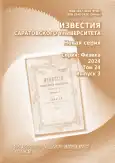Encapsulation in emulsion microgels: A high-tech strategy for the rational use of antibiotics
- Authors: Plastun V.O.1, Saveleva M.S.1, Gusliakova O.I.1, Lobanov M.E.1, Mayorova O.A.1
-
Affiliations:
- Saratov State University
- Issue: Vol 24, No 3 (2024)
- Pages: 228-238
- Section: Biophysics and Medical Physics
- URL: https://journals.rcsi.science/1817-3020/article/view/265414
- DOI: https://doi.org/10.18500/1817-3020-2024-24-3-228-238
- EDN: https://elibrary.ru/LCGACH
- ID: 265414
Cite item
Full Text
Abstract
About the authors
Valentina O. Plastun
Saratov State University
ORCID iD: 0000-0002-6235-490X
410012, Russia, Saratov, Astrakhanskaya street, 83
Mariia Sergeevna Saveleva
Saratov State University
ORCID iD: 0000-0003-2021-0462
Scopus Author ID: 57194773477
ResearcherId: M-5204-2016
410012, Russia, Saratov, Astrakhanskaya street, 83
Olga Igorevna Gusliakova
Saratov State University
ORCID iD: 0000-0001-8387-0711
Scopus Author ID: 57202360091
ResearcherId: T-5616-2018
410012, Russia, Saratov, Astrakhanskaya street, 83
Mikhail Evgenievich Lobanov
Saratov State University
ORCID iD: 0000-0002-1388-1842
410012, Russia, Saratov, Astrakhanskaya street, 83
Oksana Aleksandrovna Mayorova
Saratov State University
ORCID iD: 0000-0002-6440-3947
410012, Russia, Saratov, Astrakhanskaya street, 83
References
- Larsson D. G. J., Flach C.-F. Antibiotic resistance in the environment // Nat. Rev. Microbiol. 2022. Vol. 20. P. 257–269. https://doi.org/10.1038/s41579-021-00649-x
- Frieri M., Kuma K., Boutin A. Antibiotic resistance // J. Infect. Public Heal. 2017. Vol. 10, № 4. P. 369–378. https://doi.org/10.1016/j.jiph.2016.08.007
- Khameneh B., Diab R., Ghazvini K., Bazzaz B. S. F. Breakthroughs in bacterial resistance mechanisms and the potential ways to combat them // Microb. Pathog. 2016. Vol. 95. P. 32–42. https://doi.org/10.1016/j.micpath.2016.02.009
- French G. L. Clinical impact and relevance of antibiotic resistance // Adv. Drug Deliv. Rev. 2005. Vol. 57, № 10. P. 1514–1527. https://doi.org/10.1016/j.addr.2005.04.005
- Elder D. P., Kuentz M., Holm R. Antibiotic resistance: The need for a global strategy // J. Pharm. Sci. 2016. Vol. 105, № 8. P. 2278–2287. https://doi.org/10.1016/j.xphs.2016.06.002
- Землянко О. М., Рогоза Т. М., Журавлева Г. А. Механизмы множественной устойчивости бактерий к антибиотикам // Экол. ген. 2018. Т. 16, № 3. С. 4–17. https://doi.org/10.17816/ecogen1634-17
- Kot B. Antibiotic resistance among uropathogenic // Pol. J. Microbiol. 2019. Vol. 68, № 4. P. 403–415. https://doi.org/10.33073/pjm-2019-048
- Cao D., Shen Y., Huang Y., Liu L., Yang L., Wei Q. Levofloxacin versus ciprofloxacin in the treatment of urinary tract infections: Evidence-based analysis // Front. Pharmacol. 2021. Vol. 12. Article number 658095. https://doi.org/10.3389/fphar.2021.658095
- Wang S. S., Ratliff P. D., Judd W. R. Retrospective review of ceftriaxone versus levofloxacin for treatment of E. coli urinary tract infections // Int. J. Clin. Pharm. 2018. Vol. 40. P. 143–149. https://doi.org/10.1007/s11096-017-0560-1
- Bunduki G. K., Heinz E., Phiri V. S., Noah P., Feasey N., Musaya J. Virulence factors and antimicrobial resistance of uropathogenic Escherichia coli (UPEC) isolated from urinary tract infections: A systematic review and metaanalysis // BMC Infect. Dis. 2021. Vol. 21. P. 1–13. https://doi.org/10.1186/s12879-021-06435-7
- Jones R. N., Nguyen H. M. 1453. Cephalexin and Cefadroxil Are Not Therapeutic Equivalents for Uncomplicated Cystitis (uUTI): Further Analysis of Cefazolin Surrogate Susceptibility Testing Criteria // Open Forum Infection Diseases. 2019, October. Vol. 6. P. S530–S531. https://doi.org/10.1093/ofid/ofz360.1317
- Nordstöm R., Nystöm L., Ilyas H., Atreya H. S., Borro B. C., Bhunia A., Malmsten M. Microgels as carriers of antimicrobial peptides–effects of peptide PEGylation // Colloids Surf. A: Physicochem. Eng. Asp. 2019. Vol. 565. P. 8–15. https://doi.org/10.1016/j.colsurfa.2018.12.049
- Xiao X., Ji J., Wang H., Nangia S., Wang H., Libera M. Self-Defensive Antimicrobial Surfaces Using Polymyxin-Loaded Poly (styrene sulfonate) Microgels // ACS Biomater. Sci. Eng. 2022. Vol. 8, № 11. P. 4827–4837. https://doi.org/10.1021/acsbiomaterials.2c00783
- Cheng H., Liu H., Shi Z., Xu Y., Lian Q., Zhong Q., Liu Q., Chen,Y., Pan X., Chen R., Wang P. Long-term antibacterial and biofilm dispersion activity of an injectable in situ crosslinked co-delivery hydrogel/microgel for treatment of implant infection // Chem. Eng. J. 2022. Vol. 433. Article number 134451. https://doi.org/10.1016/j.cej.2021.134451
- Ma Q., Ma S., Liu J., Pei Y., Tang K., Qiu J., Wan J., Zheng X., Zhang J. Preparation and application of natural protein polymer-based Pickering emulsions // E-Polym. 2023. Vol. 23, № 1. Article number 20230001. https://doi.org/10.1515/epoly-2023-0001
- Кузнецов В. А., Кущев П. О., Останкова И. В., Пульвер А.Ю., Пульвер Н. А., Павлович С. В., Полтавцева Р. А. Современные подходы к медицинскому использованию сополимерных рН”и температурно-чувствительных гидрогелей (обзор) // Конденсированные среды и межфазные границы. 2020. Вып. 22, № 4. C. 417–429. https://doi.org/10.17308/kcmf.2020.22/3113
- Zheng J., Zhu C., Xu X., Wang X., Fu J. Supramolecular assemblies of multifunctional microgels for biomedical applications // J. Mater. Chem. B. 2023. Vol. 11. P. 6265–6289. https://doi.org/10.1039/D3TB00346A
- Sahiner N. Amino acid-derived Poly (L–Lysine)(p (LL)) microgel as a versatile biomaterial: Hydrolytically degradable, drug carrying, chemically modifiable and antimicrobial material // Polym. Adv. Technol. 2020. Vol. 31, № 10. P. 2152–2160. https://doi.org/10.1002/pat.4936
- Saveleva M. S., Lobanov M. E., Gusliakova O. I., Plastun V. O., Prikhozhdenko E. S., Sindeeva O. A., Gorin D. A., Mayorova O. A. Mucoadhesive emulsion microgels for intravesical drug delivery: Preparation, retention at urothelium, and biodistribution study // ACS Appl. Mater. Interfaces. 2023. Vol. 15, № 21. P. 25354–25368. https://doi.org/10.1021/acsami.3c02741
- Schneider C. A., Rasband W. S., Eliceiri K. W. NIH Image to ImageJ: 25 years of image analysis // Nat. Methods. 2012. Vol. 9. P. 671–675. https://doi.org/10.1038/nmeth.2089
- Abu T. M. M., Ghithan J., Abu-Taha M. I., Darwish S. M., Abu-hadid M. M. Spectroscopic approach of the interaction study of ceftriaxone and human serum albumin // J. Biophys. Struct. Biol. 2014. Vol. 6. P. 1–12. https://doi.org/10.1128/aac.01170-18
- Watanabe Y., Hayashi T., Takada R., Yasuda T., Saikawa I., Shimizu K. Studies on protein binding of antibiotics. I. Effect of cefazolin on protein binding and pharmacokinetics of cefoperazone // J. Antibiot. (Tokyo). 1980. Vol. 33. P. 625–635. https://doi.org/10.1038/nmeth. 2089
- Shimizu T. Studies on protein binding of cefazolin and other antibiotics // Jpn. J. Antibiot. 1974. Vol. 27. P. 296–301. https://doi.org/10.1128/aac.01170-18
- Donnelly R. F. Stability of cefazolin sodium in polypropylene syringes and polyvinylchloride minibags // Can. J. Hosp. Pharm. 2011. Vol. 64, № 4. P. 241–245. https://doi.org/10.4212/cjhp.v64i4.1035
Supplementary files









